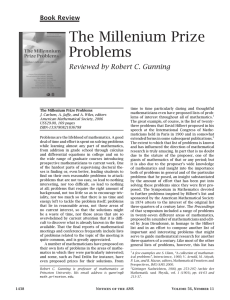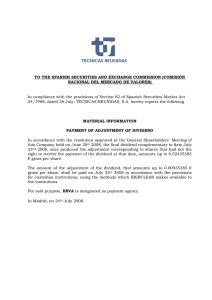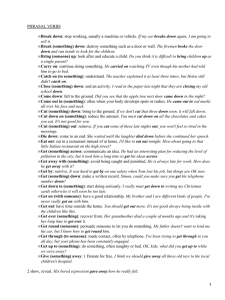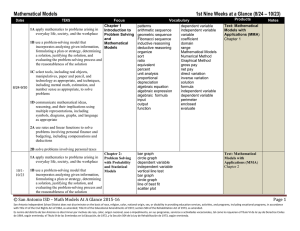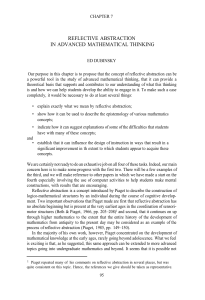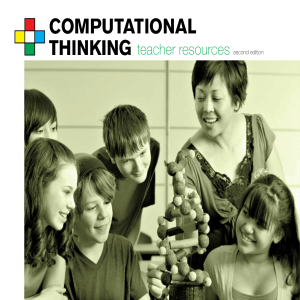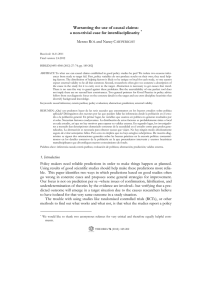an approach to the design of mathematical task sequences
Anuncio
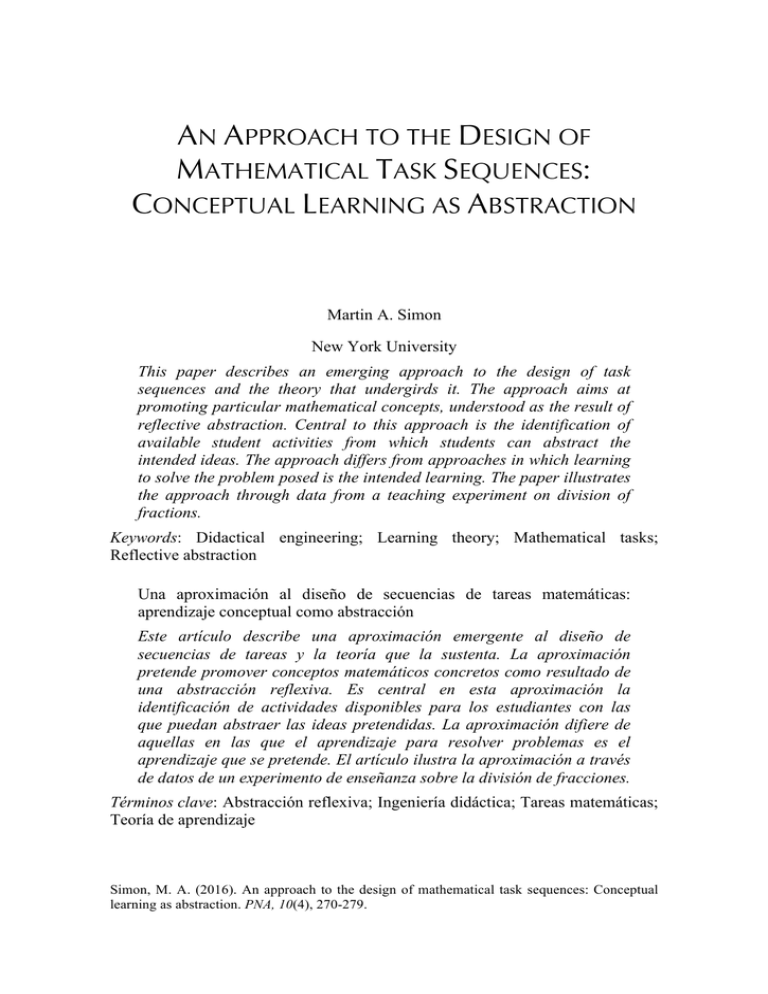
AN APPROACH TO THE DESIGN OF MATHEMATICAL TASK SEQUENCES: CONCEPTUAL LEARNING AS ABSTRACTION Martin A. Simon New York University This paper describes an emerging approach to the design of task sequences and the theory that undergirds it. The approach aims at promoting particular mathematical concepts, understood as the result of reflective abstraction. Central to this approach is the identification of available student activities from which students can abstract the intended ideas. The approach differs from approaches in which learning to solve the problem posed is the intended learning. The paper illustrates the approach through data from a teaching experiment on division of fractions. Keywords: Didactical engineering; Learning theory; Mathematical tasks; Reflective abstraction Una aproximación al diseño de secuencias de tareas matemáticas: aprendizaje conceptual como abstracción Este artículo describe una aproximación emergente al diseño de secuencias de tareas y la teoría que la sustenta. La aproximación pretende promover conceptos matemáticos concretos como resultado de una abstracción reflexiva. Es central en esta aproximación la identificación de actividades disponibles para los estudiantes con las que puedan abstraer las ideas pretendidas. La aproximación difiere de aquellas en las que el aprendizaje para resolver problemas es el aprendizaje que se pretende. El artículo ilustra la aproximación a través de datos de un experimento de enseñanza sobre la división de fracciones. Términos clave: Abstracción reflexiva; Ingeniería didáctica; Tareas matemáticas; Teoría de aprendizaje Simon, M. A. (2016). An approach to the design of mathematical task sequences: Conceptual learning as abstraction. PNA, 10(4), 270-279. An Approach to the Design of Mathematical… 271 Our research and theoretical work build on several core ideas advanced by Piaget and therefore could be considered constructivist in orientation. Multiple theoretical perspectives are needed to do the work of design of mathematical tasks. Consistent with this view, we see our work as complementary to the work of research programs that work from a different core set of theoretical constructs. The emerging task design theory that I present here is focused on the learning of mathematical concepts and as such offers an approach to addressing difficult to learn concepts and to working with students who are struggling to learn specific concepts. This task design approach does not address other important areas of learning mathematics, particularly the important area of mathematical problem solving. Therefore, the approach is meant to complement problem-solving approaches, not replace them. The emerging task design theory is a product of the learning through activity research program aimed at investigating conceptual learning, understood as abstractions from one’s mathematical activity. In our empirical studies, we focus on activity that occurs in the context of carefully designed sequences of mathematical tasks. We employ a spiral strategy in which we design task sequences to study learning through student activity, and we use what we come to understand about learning to improve our understanding of task design, and so on. THEORETICAL BASIS The theoretical basis of our research program derives from Piaget’s (2001) work on reflective abstraction. DiSessa and Cobb (2004) pointed out, “Piaget’s theory is powerful and continues to be an important source of insight. However, it was not developed with the intention of informing design and is inadequate, by itself, to do so deeply and effectively” (p. 81). Our research program is aimed at elaborating reflective abstraction in a way that can inform instructional design. Two subconstructs of reflective abstraction are foundational to our work: (a) goal-directed activity and (b) reflection. Goal-directed activity includes both physical and mental activity. The notion of goal-directed is important, because the learners’ goals partially determine both what knowledge they call upon and what they pay attention to and can notice. Reflection, following von Glasersfeld (1995), refers to an innate tendency—often not conscious—to distinguish— associate—commonalities in one’s experience—e.g., in one’s activity. In our research and theoretical work, consistent with Piaget and others, (e.g., Hershkowitz, Schwarz, & Dreyfus, 2001; Mitchelmore & White, 2008), we consider mathematics conceptual learning as the process of developing new and more powerful abstractions. Again following Piaget, we understand abstractions PNA10(4) M. A. Simon 272 to be learned anticipations and reflective abstractions1 to be those abstractions that result from reflection on one’s activity and result in knowledge of logical necessity (Simon, 2006; Simon, in press). Our task design approach builds on this theoretical base and involves specifying hypothetical learning trajectories (Simon, 1995) at multiple levels. In this article, I focus on the level of design of particular concepts, not the planning of trajectories for larger mathematical topics. A hypothetical learning trajectory consists of three components: (a) a learning goal, (b) a set of mathematical tasks, and (c) a hypothesized learning process. Whereas the specification of the learning goal generally precedes the specification of the tasks and hypothesized learning process, these latter two components necessarily co-emerge. That is, the learning process is at least partially determined by the tasks used, and the tasks used must reflect conjectures about possible learning processes. The design approach outlined here focuses particularly on the design process with respect to these two components. I briefly summarize the rationale for the learning through activity approach to task design. If we understand mathematical concepts as the result of reflective abstraction, and if we understand reflective abstraction as deriving from the learner’s activity, it should be possible to design task sequences that elicit the requisite activity and promote abstraction from that activity. (For further elaboration of the rationale and theoretical basis of the research program, see Simon, Placa, & Avitzur, 2016, and Simon et al., 2010) In the next section, I provide an example from our research and follow that with a discussion of the key steps in the design process. INSTRUCTIONAL EXAMPLE In this section, I present an instructional example from a one-on-one teaching experiment. The purpose of the teaching experiment was to promote and analyze students’ learning of new concepts—making of an abstraction—as they engaged in mathematical activity. Towards this end, we engaged them in a sequence of tasks and restricted the researcher’s role to probing thinking and posing subsequent tasks. The student, Erin, was an undergraduate prospective elementary teacher— one of three that participated in the study. Pre-assessment showed she lacked understanding of both the meaning of fraction division and the invert-andmultiply algorithm, although she had a rote knowledge of the procedure. In sessions, prior to the one described here, we worked on the meaning of fraction division. 1 See Simon, Placa, and Avitzur (2016) for a full description of our elaboration of the reflective abstraction construct. PNA 10(4) An Approach to the Design of Mathematical… 273 The goal of this session can be articulated at two levels of specificity. First, we wanted her to reinvent a common-denominator algorithm for division of fractions. More specific in terms of the understanding involved, we wanted her to understand the invariance of division as the common units of the dividend and divisor are varied. The task sequence, developed by the author (described in full in the Appendix http://goo.gl/OJqznu), began with division-of-fraction word problems whose dividend and divisors had common denominators. Erin was asked to solve them by drawing a diagram. She was able to solve the first task without 7 difficulty—I have of a gallon of ice cream, and I want to give each of my 8 1 friends a gallon portion. To how many friends can I give ice cream? The task 8 sequence progressed to word problems in which the dividend and the divisor still had common denominators, but the divisor did not divide the dividend equally 8 3 and then to similar tasks presented as number expressions (e.g., ÷ ). Erin’s 5 5 8 3 solution process can be summarized as follows. Example of actions for ÷ in 5 5 parentheses. ♦ Draws the dividend—draws 2 whole rectangles divided into fifths, shades 2 8 of one rectangle leaving unshaded. 5 5 3 ♦ Identifies groups the size of the divisor (circles each ). 5 ♦ Counts those groups (counts 2 groups). 2 ♦ Identifies the remainder—the ungrouped part of the dividend ( r = ). 5 ♦ Identifies the fractional part of the quotient by determining the fraction of 2 2 3 the divisor represented by the remainder ( is of ). 5 3 5 After a number of such tasks, the researcher changed the nature of the task. He gave Erin a task and announced that the numbers were too messy to draw a 23 7 diagram. The first such task was ÷ . Erin made it clear that she did not 25 25 know the answer, and the researcher encouraged her to talk through a diagram solution without actually drawing. This she was able to do without difficulty and 7 2 arrive at the answer. The following task was . Again, Erin did not ÷ 167 167 PNA10(4) M. A. Simon 274 know the answer and solved the task by doing a mental (verbal) run of her 7 2 diagram drawing strategy. Finally, the researcher gave her —same ÷ 103 103 numerators as the previous task2. Erin responded immediately with the answer, “three and a half”, and explained that she did not need to use the denominator. When pushed to justify her claim, she drew a rectangle divided into seven boxes and argued that she could group them into groups of two parts regardless of the size of the parts represented—e.g., 167ths, 25ths. An additional task verified that Erin did not over-generalize for tasks that did not have common denominators and that she could convert to common denominators to use her reinvented algorithm—make common denominators and divide the numerators. Assessment the following week convinced us that she retained her algorithm, she could justify it, and she could call on the same reasoning to think about the invariance when composite units were involved—e.g., why 2400 divided by 400 is equal to 24 divided by 4. Simon et al. (2010) gave a more detailed look at the data, analysis, and explanation of Erin’s learning. My focus here is the abstraction that Erin made. That abstraction became evident when Erin quickly gave the answer “three and a half”. So what did Erin abstract? Erin abstracted that regardless of the size of the parts—assuming common denominators, the quotient would always be the same and would be equal to the quotient of the numerators. Readers at this point might be tempted to argue that Erin just saw a number pattern. However, remember that up to this point in the teaching experiment, Erin had not seen two tasks with the same pair of numerators. Thus, there was no pattern to observe. The first time she encountered the situation she anticipated the result.3 Furthermore, her conclusion was not only about the task in question. She now knew that she could find the quotient of any division of fractions involving common denominators solely by dividing the numerators. And, she was able to justify her conclusions using an improvised diagram related to her diagram drawing. These three indications make it clear that the abstraction in question was conceptual in nature and not due to noticing a pattern in the numbers. THE DESIGN APPROACH The task sequence that fostered Erin’s reflective abstraction is an example of the general design approach that we use. The first two steps in our design approach are the first two steps in most instructional design that is aimed at conceptual 2 The fact, that this problem had the same numerators as the previous one, was not pointed out to Erin. 3 Simon (2006) presents a distinction between reflective abstraction and empirical learning processes. I have argument that Erin’s learning was the result of reflective abstraction as there was no empirical pattern to observe. PNA 10(4) An Approach to the Design of Mathematical… 275 learning: (a) Assessing student understanding, and (b) articulating a learning goal4 for the students relative to their current knowledge. It is after these first two steps that our approach diverges. Our third step is to specify an activity that students currently can call on that can be the basis for the abstraction specified in the learning goal. The fourth step is to design a task sequence and related hypothesized learning process—the remaining aspects of the hypothetical learning trajectory. The task sequence must both elicit the intended student activity and lead to the intended abstraction on the part of the students. The process must account for not only the overt activity of the students, but the mental activities that are expected to accompany those overt activities. I will not focus on steps beyond step four —e.g., symbolizing, introducing vocabulary, discussing justification, because those steps also are common to many approaches. I will now use the example of the division-of-fractions task sequence to illustrate steps three and four of our task design approach. The consideration of what activity to use as the basis for promoting the abstraction is sometimes similar to design in Realistic Mathematics Education (RME) (Gravemeijer, 1994). That is, it often involves a consideration of students’ informal strategies. Whereas RME focuses on developing progressively more formal solution strategies, our approach is focused on developing concepts by developing abstractions from those activities.5 In many of our design situations, we have a specified learning goal and then endeavor to identify an available activity that can be used. Our example of division of fractions illustrates a design in which there was an interaction between step two, setting the learning goal, and step three, identifying a useful activity. When considering students’ informal strategies and considering diagram drawing, we realized that students’ informal diagram solutions would more naturally support development of abstractions related to a common-denominator algorithm for division of fractions than an invert-and-multiply algorithm. Thus, the goal not only affected the identification of the activity, but the activity available affected the specific goal towards which the design was oriented.6 Articulation of conceptual learning goals is a problematic issue not covered here. It is a theoretical and empirical challenge to specify learning goals in a way and level of specificity that adequately guides instructional design (as well as instruction and assessment). See Simon (in press) for theoretical work in this area. 5 Although there are often overlaps in what is learned by students using these two approaches, I emphasize here the differences in the primary aim and the theory built to achieve that aim. In our work, we build on aspects of RME, particularly their use of “model of becoming model for” (Gravemeijer, 1994). 6 The target algorithm is not itself a conceptual learning goal. We still needed to specify the understanding involved (“t to understand the invariance of division as the common units of the dividend and divisor are varied”). However, I wanted to use the process of coming to the goals to illustrate how the knowledge/activities available can influence the goals that are set. 4 PNA10(4) M. A. Simon 276 The challenge then was to construct a hypothetical learning trajectory. We began with division of fractions word problems and followed them up with numerical tasks—no context—to elicit a diagram drawing activity like the one that Erin used—outlined above. We then moved to larger numbers for the denominators and invited mental runs of the diagram drawing activity, which was a change in the activity from the researchers’ perspective. The mental activity involved in the mental runs was the activity that led to the intended abstraction. Let us examine how the activity of the mental runs was different from the diagram drawing activity. In the diagram solutions, the student first focused on how to create the number of equal parts in the rectangular unit. The focus then shifted to a sequence of two separate counting acts. First, she counted parts to circle divisor-sized groups. Second, she counted the number of circles produced. In the mental runs, the student could dispense with the first step by simply announcing, “I would draw twenty-three twenty-fifths”. The focus shifted to the quantities that she needed to relate. In the mental run she had to use whole number division to find out how many divisor-sized groups were in the dividend. She could no longer count the number of groups she had in front of her. She was comparing multiplicatively the number of parts in the dividend with the number of parts in the divisor. The original diagram drawing activity provided an important step towards this activity, but was unlikely to lead directly to the intended abstraction, because the student did not need to conceptualize the multiplicative comparison. Doing a couple mental runs did not in itself lead to the intended abstraction. The researcher at that point posed a task with the same numerators as the previous task. The purpose of this particular task was to increase the possibility that the student would see the commonality in her activity and, as a result, anticipate that the answer had to be the same and realize that it was not dependent on the value of the common denominators. So how do we explain the resulting change in thinking? As mentioned earlier, in doing the mental runs, Erin was able to give minimal attention to establishing the dividend—she merely needed to state that she would draw it. This initial statement established the size of the parts, so that—just as in the diagram drawing—she could focus on the number of parts of that size available and the number of parts of that size in a group. Thus, she naturally, without necessarily making a conscious decision, paid particular attention to how many total parts and how many parts in a group. This “focus of attention” (Simon et al., 2010) was not because she considered the denominator unimportant, but because she had established he size of the parts and was anticipating her next step, a computation involving these two quantities. In the third task of this set, when Erin was faced once again with the same pair of numerators and different common denominators, she realized that she was about to enact the same activity as in the previous task. At that moment, she also realized why the size of the common denominators did not change the quotient. PNA 10(4) An Approach to the Design of Mathematical… 277 This was an example of Erin’s reflection on her—mental—activity. That is, she perceived the commonality in her activity in the two cases that led to an abstraction. She abstracted that the division of fractions with like denominators is equivalent to the division of the numerators—and could explain why it had to be so. CONCLUSIONS I highlight two features of our task design approach that can be seen in the example provided above. First, the approach provides a theoretically-based strategy for promoting specific mathematical understandings. It contrasts with strategies in which students must make a problem-solving leap to solve the given task—or hear the solutions of more able peers. Erin was able to solve every task she was given without difficulty. Her progress stemmed from her reflection on her activity, not from a problem solving breakthrough. Although mathematics teaching cannot cause learning, our approach involves engineering task sequences so that participating students predictably develop the ability to make the new abstraction. Second, the learning goal is not to learn to solve the tasks, as it is in many approaches. The tasks are made to elicit activities that the students already have available. As stated, Erin was able to solve all of the tasks prior to making the intended abstraction. Further, she was not consciously trying to find an easier way or to invent an algorithm. Her learning was a product of reflection on her activity across a sequence of tasks. Let us examine some of the implications of this approach to task design. ♦ This design approach has particular affordances for research. Used with a teaching experiment methodology—design and implementation cycles, it provides an opportunity to understand in greater depth the interplay among goal-directed activity, reflection, and conceptual learning. (This is discussed in depth in Simon et al., 2010) ♦ This design approach provides a way to design task sequences for concepts that students traditionally do not learn well. The approach focuses the instructional designers on identifying key activities—available to the students—that can serve as the basis for abstractions that are not readily made. ♦ Small group work, using task sequences of the kind discussed here, can lead to somewhat different class discussions. If students are making the new abstraction as a result of their engagement with the task sequence— and not needing to hear the abstraction from others, discussions can focus more on articulation of the new idea, justification, and establishing the idea as taken-as-shared knowledge. ♦ The design approach has potential to address issues of equity in two ways. First, many students who have conceptual gaps early on seem to never PNA10(4) M. A. Simon 278 recover. This design approach provides a methodology for building up the specific experience needed to make particular abstractions. Second, success in promoting the new abstractions during small group engagement with the tasks can lead to a greater number of students participating in and benefiting from the class discussions that follow. That is, a greater number of the students might have the experiential base for contributing to the articulation of the abstracted relationship being discussed. One final point that was discussed briefly at the beginning of this paper is the relationship of our approach with mathematical problem solving. The approach that I have described and exemplified does not focus on students developing their problem solving abilities. Rather it focuses narrowly on the development of mathematical concepts. Developing problem solving abilities is a key part of mathematics education. Students may learn concepts through problem solving lessons. Our approach is in no way intended to minimize the importance of lessons in which that is the case. Rather, our approach provides an additional tool that has the potential for success in conceptual areas where mathematics educators tend to be less successful. Acknowledgment This research was supported by the National Science Foundation (REC0450663 and DRL-1020154). The opinions expressed do not necessarily reflect the views of the foundation. REFERENCES DiSessa, A., & Cobb, P. (2004). Ontological innovation and the role of theory in design experiments. The Journal of the Learning Sciences, 13(1), 77-103. Gravemeijer, K. P. E. (1994). Developing realistic mathematics education. Utrecht, The Netherlands: CD-ß Press/Freudenthal Institute. Hershkowitz, R., Schwarz, B., & Dreyfus, T. (2001). Abstraction in context: Epistemic actions. Journal for Research in Mathematics Education, 32(2), 195-222. Mitchelmore, M. C., & White, P. (2008). Teaching mathematics concepts: Instruction for abstraction. In M. Niss (Ed.), ICME-10 Proceedings [CD]. Denmark: Roskilde University, IMFUFA, Department of Science, Systems and Models. Piaget, J. (2001). Studies in reflecting abstraction (R. L. Campbell, Ed. & Trans.). Philadelphia, PA: Psychology Press. Simon, M. A. (1995). Reconstructing mathematics pedagogy from a constructivist perspective. Journal for Research in Mathematics Education, 26(2), 114-145. PNA 10(4) An Approach to the Design of Mathematical… 279 Simon, M. A. (2006). Key developmental understandings in mathematics: A direction for investigating and establishing learning goals. Mathematical Thinking and Learning, 8(4), 359-371. Simon, M. A. (in press). Explicating mathematical concept and mathematical conception as theoretical constructs for mathematics education research. Educational Studies in Mathematics. Simon, M. A., Placa, N., & Avitzur, A. (2016). Participatory and anticipatory stages of mathematical concept learning: Further empirical and theoretical development. Journal for Research in Mathematics Education, 47(1), 63-93. Simon, M. A., Saldanha, L., McClintock, E., Karagoz Akar, G., Watanabe, T., & Ozgur Zembat, I. (2010). A developing approach to studying students’ learning through their mathematical activity. Cognition and Instruction, 28(1), 70-112. von Glasersfeld, E. (1995). A constructivist approach to teaching. In L. Steffe & J. Gale (Eds.), Constructivism in Education (pp. 3-16). Hillsdale, NJ: Lawrence Erlbaum. A previous version of this document was originally published as Simon, M. A. (2013). Developing theory for design of mathematical task sequences: Conceptual learning as abstraction. In C. Margolinas (Ed.), Proceedings of ICMI Study 22 (Vol. 1, pp. 503-510). Oxford, United Kindom: ICMI. Martin A. Simon New York University msimon@nyu.edu Received: September 2015. Accepted: March 2016. Handle: http://hdl.handle.net/10481/41628 PNA10(4)
